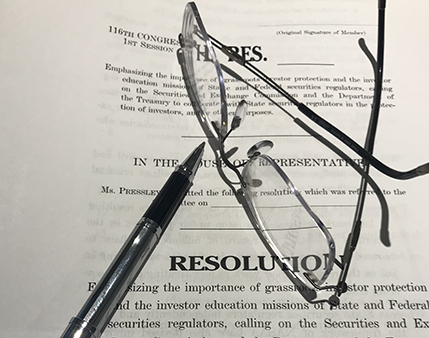President’s Remarks
Deborah Bortner
Director of Securities, Washington State Dept. of Financial Institutions
President, North American Securities Administrators Association
September 19, 2000
NASAA Annual Conference
Montreal, Canada
Thank you, Brad, for your kind introduction. Brad, I want to thank you, publicly, for the great job you’ve done over the last year as NASAA president…thank you for your counsel, your stewardship, your hard work and your vision…all of which served NASAA so well. It’s been a successful year for NASAA and you deserve thanks from all of us.
There are several major issues I want to discuss today, among them technology, our changing marketplace and the need for even more uniformity of regulation.
During my tenure as a regulator, I’ve seen incredible changes in the marketplace and in the regulation of that marketplace. While there have been lots of changes –and many more to come–one thing hasn’t changed: Our mission– which is to protect and educate investors and help legitimate businesses tap the capital markets.
The biggest changes I’ve seen have been: the globalization of our securities markets…the rise of technology…and how these two trends have made uniformity of regulation more important than ever before. When I first began my career, what we did in Washington state had very little effect on the rest of the nation. State securities regulation was essentially local.
Of course, all that has changed—and so have we. We need to continue to focus on ways we can work together even more effectively to protect investors. The rise in technology has made it more important than ever to work with our fellow regulators at the SEC and NASDR to ensure we adopt consistent standards. In something as important to our economy as our securities markets—Wall Street–we must make sure that regulation complements, not restrains,
innovation and legitimate commerce.
As we seek to protect investors, there will be regulatory hoops that even legitimate businesses will have to jump through, but we must continue to keep them to a minimum. As many of you know, I am chairing a special NASAA task force looking at state licensing issues. Among other things, we are exploring ways to promote and increase uniformity wherever possible. We are also examining ways to reduce the cost and complexity of regulatory compliance related to multi-state licensing. I believe people in this industry should be able to easily get licensed in different jurisdictions–as long as they have clean records. Our task force is asking each state to evaluate whether the requirements in that state protect investors and add value to the whole process of regulating the marketplace.
We can increase uniformity by using the technology we already have. WebCRD, which is now a year old, can permit automatic licensing of new applicants who have no disciplinary history. Just recently, 7 more states agreed to become automatic states–for a total of 34 jurisdictions. All of these states automatically license new agents with no disciplinary history. With some minor changes to the CRD, more states could do the same.
Here’s one example of how it would work. Some states are required by law to check resident/applicants against a list of residents in that state who have failed to pay child support. If the CRD allowed states to keep resident/applicants in their manual queues, more states could provide for automatic licensing. This is a minor change but could yield a major benefit in terms of making states more uniform. There are other ways in which technology can help. Today we have access to all sorts of web sites to give us information. From the SEC’s Edgar site to sites maintained by agencies at the state level.
We need to take even more advantage of the Internet…whether it’s in the agent, broker-dealer, corporation finance or investment adviser areas…The challenge is: How can we find what we need to know by using the Internet without asking the issuer or applicant for the information? For example, a lot of states ask for incorporation documents from BD applicants. Most secretaries of state are on-line…the question is…can the reviewer get this information from another source? Most states require firms to file financial statements as part of their BD application. We’re asking NASDR to share their FOCUS database so that each state will no longer have to ask each firm to produce that information.
Another example: Why not accept Form BD directly from CRD instead of requiring a signed hard copy? This isn’t just a matter of training…it’s accepting something new. Sure, the form may look a little different in an electronic format, but we need to get used to it. Change can be hard…hard for us, hard for our staffs…but we’ve got to do it…we’ve got to learn to be more flexible. Another very important piece of technology is the Investment Adviser Registration Database…the IARD clearly has the potential to do for investment advisers what the CRD did for broker-dealers—create more uniformity.
Today many of us have different processes for licensing investment advisers. The IARD will change that. It’s a matter of being trained to use the technology and then trusting that it’s doing its job as well as we are. During our training sessions, we will be working with our state examiners to share best practices on how to review the application of an IA or IA rep. That’s why NASAA will use its resources to train our members how to use this new system. IARD also levels the playing field between IA reps and broker-dealer agents. Investors should be able to find out about an IA rep just as they do a BD agent. It hasn’t been a level playing field until now because it’s been hard to find an IA rep’s disciplinary history.
That’s why I decided that my state, Washington, will mandate filing over the IARD for our state- licensed advisers. I strongly urge other states to consider this mandate to make the database as useful to investors as it can be. State participation is crucial to the success of the IARD. Getting this system off to a successful start will be one of my highest priorities as NASAA president. I am very encouraged that all 50 states are taking part in the IARD pilot program.
Another area of interest to the legitimate industry is the so-called vacationing client issue. I think this is extremely important. Our jobs and responsibilities frequently take us beyond our state borders. Our ociety is too mobile for us to require a firm or an agent to be registered in every conceivable jurisdiction that a client could temporarily be visiting. As long as the broker-dealer and agent are registered where the investor resides, why shouldn’t we allow that investor the freedom to transact business while temporarily away from home?
In the corporate finance area…a special interest of mine throughout my career, I commit to continue to make progress in the coming year. Some history: I am proud to say that in the early 80’s my state, working with members of the industry, developed the idea of a fill-in-the-blank offering circular – an idea that was later developed into SCOR. The program involving use of SCOR has helped hundreds of small businesses “go public” through the use of that intuitive document. SCOR, in turn, is the foundation for our programs of regional review of small company offerings.
I’m committed to working hard to make coordinated review of small equity offerings a reality in every state during my tenure as NASAA president. We’re not quite there yet, but we’re very close. In fact, I am very happy to announce that just last week Nebraska and Minnesota agreed to join our national review program. My vision is to promote coordinated review of other types of offerings such as Direct Participation Programs and debt offerings. In fact, every filing that’s made in more than one state is a candidate for coordinated review. Coordinated review is also a huge resource- and time-saver. It helps us leverage our expertise and staff. States with a particular expertise or states with larger staffs will be able to share their resources by acting as lead states.
During my year as president I also want to work at the grass-roots level to spread the word about the success of coordinated review and SCOR and thereby increase the use of these programs …I’d like to reach out to economic development councils in each state, the Small Business Administration and incubators like ACE-Net. All of our governors are interested in jobs and helping small businesses and rural development. We should do all we can to help. In the area of enforcement…I agree with Brad Skolnik and many of my colleagues that we need to make the costs of enforcement penalties more than the benefits of illicit gains.
For years we’ve had people violating the law and being told they don’t have to admit or deny anything – just stop it and don’t do it again. Unless we put criminals in jail we’re not going to see a true reduction in the problems. As my boss always says, do the big cases where you get the bang for the buck and they will have a deterrent effect. It makes sense to bring criminal cases against people who deserve it. And that’s a big part of NASAA’s strategic plan.
State securities regulators play a vital role in educating investors. We may be the local cops on the beat but we can’t be on every corner. The best person to protect the investor is the investor himself. The key is to educate people to protect themselves. NASAA will continue to focus on educating all three of our target groups – seniors, adults and school-aged kids. It’s critical that we teach kids early not only about the value of saving and investing, but also how to avoid getting taken. NASAA, along with the NASD, the Investor Protection Trust and the National Institute for Consumer Education have developed a high school curriculum called Financial Literacy 2001. In the first two years of that program an estimated 6,000 teachers in 47 states have taken part in training programs to learn how to teach financial literacy. Over 24,000 teachers have been provided a free state- specific copy of that curriculum. We also need to creatively partner with industry on investor education. A year ago, in Washington state, for example, we developed a web site called the Investing Online Resource Center and we partnered with the online brokerage industry to make it available to the public via hyperlinks from their websites. Since last December this site has received over 10 million “hits.” I’m going to work in the coming year to get NASAA members and more brokerdealers involved in this project. After all, we all benefit from well-educated
investors.
As we move into the 21st Century I urge my fellow regulators to consider what we do and ask some tough questions:
- Just because we can, should we?
- Just because our statutes give us the authority to take a certain action, should we?
- Just because we have the authority to ask for a certain document, should we—if it doesn’t help us protect investors?
- We need to ask these questions every day to make sure that we can, in good conscience, answer, “Yes, we should” and why.
To conclude, despite all the changes in our markets and in the way we regulate and despite the changes yet to come….our core mission has not and will not change—
- to protect and educate investors,
- to prevent fraud and punish those who would commit fraud and
- to help legitimate businesses raise the money they need.
Our jobs as regulators have never been more important or more challenging and rewarding.
Again, I’m grateful and excited for this opportunity to represent you as NASAA President. I look forward to working with all of you in the year ahead.
September 19, 2000










